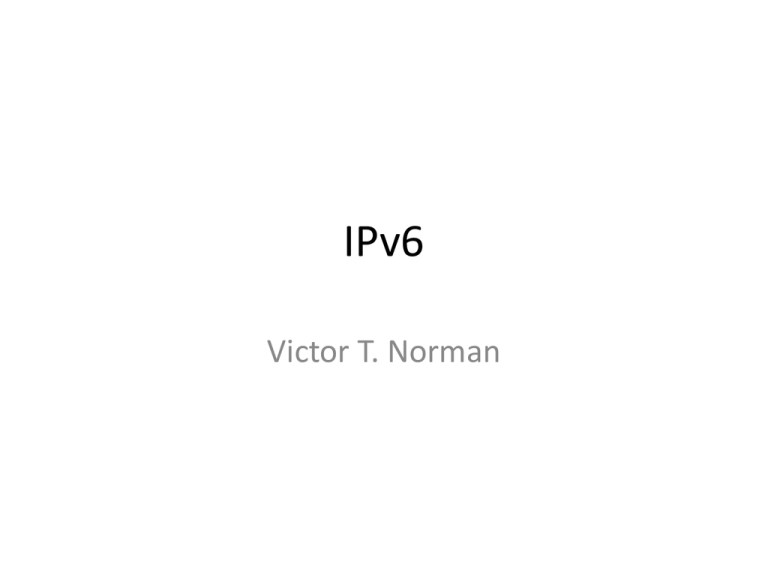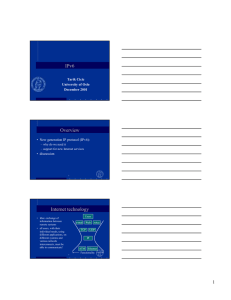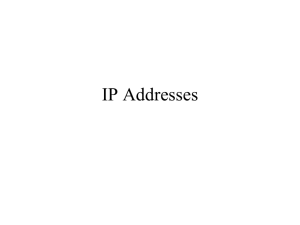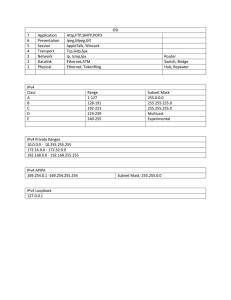IPv6 Powerpoint
advertisement

IPv6 Victor T. Norman IPv4 • Strengths: IPv4 has accommodated: – Extreme growth in networks. – Large variety of and changes in hardware characteristics Required for real– Changes in frame sizes. • Weaknesses: time audio and video. – 32 bit addresses we have run out! – Can not guarantee service – consistent jitter, e.g. IPv4 / IPv6 Similarities • Connectionless protocol • Contains destination address and uses packet switching. • Contains a counter to ensure packets take a maximum number of hops. IPv4 / IPv6 Differences • All fields are different – nothing carried over from IPv4. • 128 bit addresses (4 times larger than IPv4). • Uses base header + extension headers. – Base header has only required fields; extension headers have fields needed in some situations. – IPv4 has fields in the header that are rarely used. • Fragmentation very different. IPv4 / IPv6 Differences • Has support for real-time traffic. – Sender/receiver can establish a path with known characteristics – not possible in base IPv4. • IPv6 allows future extensions to be added. Packet format • Base header, followed by N optional extension headers, followed by payload. • Base header 2x larger than IPv4, but fewer fields. Fields • Version = 6 (note: in same position in IPv4 header) • Traffic class uses “Differentiated services” definitions – low latency, low jitter, etc. • Payload length: just for payload. • Hop limit (like ttl but named better). • Flow label: identify a network path – unlikely to be used nowadays. • Next header: type of the next header – or type of data in payload if no next header. Fragmentation • Sending host is responsible for fragmenting and sending fragments small enough to reach destination. • Routers do not fragment – they send ICMPv6 error message and drop packet. • Sending hosts may use path MTU discovery. – Or, easier: use minimum MTU of 1280 octets. Addressing • Like IPv4: – One address per interface – Address split into network part and host part – each fixed at 64 bits. • Unlike IPv4: – Can have multi-level hierarchy within the address. • ISP part, company part, site part, building part, etc… Addressing • 3 kinds of address: – Unicast, multicast, anycast. – Anycast: can assign same address to a cluster of computers and IPv6 will route to one of them. • Colon hexadecimal notation (colon hex) – 8 sets of 4 hex characters (2 bytes) separated by colons: 69DC:8864:FFFF:FFFF:0:1280:8C0A:FFFF – Zero-compression: multiple 0-bytes skipped: • 69DC:8864::F1 IPv4-mapped IPv6 Addresses • • • • First 80 bits are 0. Next 16 bits are 1. Last 32 bit are IPv4 address. Often written with last bytes in dotteddecimal notation: • ::FFFF:192.0.2.128 Stateless Address Autoconfiguration (SLAAC) • • • • Like DHCP – but a host can self-configure. Host sends ICMPv6 router discovery message. Router responds with network-layer info. Host uses network part and uses its (unique) MAC address as part of the host part of the address. • Whole networks can be renumbered with router prefix advertisements (theoretically). Using IPv6 with sockets • Using an OS with dual-stack implementation, a socket can handle both IPv6 and IPv4. – Using IPv4-mapped IPv6 addresses. • Otherwise, have to open 2 sockets – one for IPv4 and one for IPv6. DNS and IPv6 • DNS has supported IPv6 addresses for a long time – using AAAA records. • Reverse lookups work too, via ip6.arpa domain. Transition Strategies • Backbone Internet uses IPv4 now, but ISP can’t issue any more IPv4 addresses… • New customers get IPv6 addresses.






